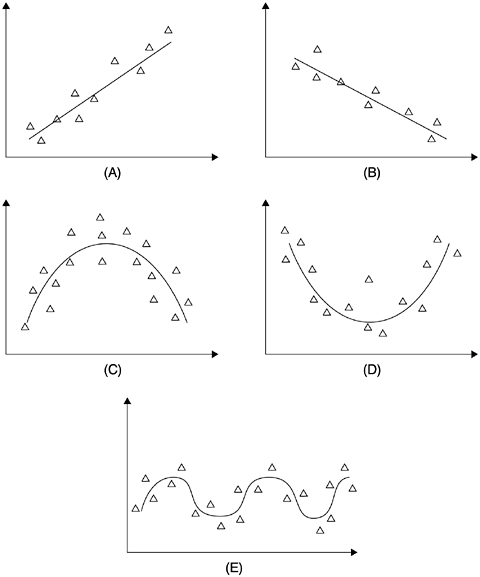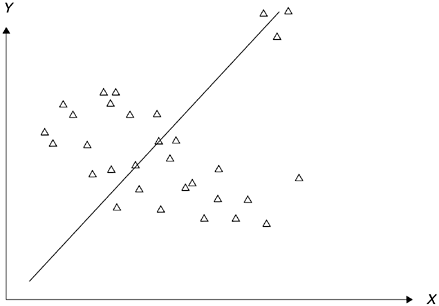Be Careful with Correlation
Correlation is probably the most widely used statistical method to assess relationships among observational data (versus experimental data). However, caution must be exercised when using correlation; otherwise , the true relationship under investigation may be disguised or misrepresented. There are several points about correlation that one has to know before using it. First, although there are special types of nonlinear correlation analysis available in statistical literature, most of the time when one mentions correlation, it means linear correlation. Indeed, the most well-known Pearson correlation coefficient assumes a linear relationship. Therefore, if a correlation coefficient between two variables is weak, it simply means there is no linear relationship between the two variables . It doesn't mean there is no relationship of any kind.
Let us look at the five types of relationship shown in Figure 3.6. Panel A represents a positive linear relationship and panel B a negative linear relationship. Panel C shows a curvilinear convex relationship, and panel D a concave relationship. In panel E, a cyclical relationship (such as the Fourier series representing frequency waves) is shown. Because correlation assumes linear relationships, when the correlation coefficients (Pearson) for the five relationships are calculated, the results accurately show that panels A and B have significant correlation. However, the correlation coefficients for the other three relationships will be very weak or will show no relationship at all. For this reason, it is highly recommended that when we use correlation we always look at the scattergrams. If the scattergram shows a particular type of nonlinear relationship, then we need to pursue analyses or coefficients other than linear correlation.
Figure 3.6. Five Types of Relationship Between Two Variables

Second, if the data contain noise (due to unreliability in measurement) or if the range of the data points is large, the correlation coefficient (Pearson) will probably show no relationship. In such a situation, we recommend using the rank-order correlation method, such as Spearman's rank-order correlation. The Pearson correlation (the correlation we usually refer to) requires interval scale data, whereas rank-order correlation requires only ordinal data. If there is too much noise in the interval data, the Pearson correlation coefficient thus calculated will be greatly attenuated. As discussed in the last section, if we know the reliability of the variables involved, we can adjust the resultant correlation. However, if we have no knowledge about the reliability of the variables, rank-order correlation will be more likely to detect the underlying relationship. Specifically, if the noises of the data did not affect the original ordering of the data points, then rank-order correlation will be more successful in representing the true relationship. Since both Pearson's correlation and Spearman's rank-order correlation are covered in basic statistics textbooks and are available in most statistical software packages, we need not get into the calculation details here.
Third, the method of linear correlation (least-squares method) is very vulnerable to extreme values. If there are a few extreme outliers in the sample, the correlation coefficient may be seriously affected. For example, Figure 3.7 shows a moderately negative relationship between X and Y . However, because there are three extreme outliers at the northeast coordinates, the correlation coefficient will become positive. This outlier susceptibility reinforces the point that when correlation is used, one should also look at the scatter diagram of the data.
Figure 3.7. Effect of Outliers on Correlation

Finally, although a significant correlation demonstrates that an association exists between two variables, it does not automatically imply a cause-and-effect relationship. Although an element of causality, correlation alone is inadequate to show the existence of causality . In the next section, we discuss the criteria for establishing causality.
What Is Software Quality?
Software Development Process Models
- Software Development Process Models
- The Waterfall Development Model
- The Prototyping Approach
- The Spiral Model
- The Iterative Development Process Model
- The Object-Oriented Development Process
- The Cleanroom Methodology
- The Defect Prevention Process
- Process Maturity Framework and Quality Standards
Fundamentals of Measurement Theory
- Fundamentals of Measurement Theory
- Definition, Operational Definition, and Measurement
- Level of Measurement
- Some Basic Measures
- Reliability and Validity
- Measurement Errors
- Be Careful with Correlation
- Criteria for Causality
Software Quality Metrics Overview
- Software Quality Metrics Overview
- Product Quality Metrics
- In-Process Quality Metrics
- Metrics for Software Maintenance
- Examples of Metrics Programs
- Collecting Software Engineering Data
Applying the Seven Basic Quality Tools in Software Development
- Applying the Seven Basic Quality Tools in Software Development
- Ishikawas Seven Basic Tools
- Checklist
- Pareto Diagram
- Histogram
- Run Charts
- Scatter Diagram
- Control Chart
- Cause-and-Effect Diagram
- Relations Diagram
Defect Removal Effectiveness
- Defect Removal Effectiveness
- Literature Review
- A Closer Look at Defect Removal Effectiveness
- Defect Removal Effectiveness and Quality Planning
- Cost Effectiveness of Phase Defect Removal
- Defect Removal Effectiveness and Process Maturity Level
The Rayleigh Model
- The Rayleigh Model
- Reliability Models
- The Rayleigh Model
- Basic Assumptions
- Implementation
- Reliability and Predictive Validity
Exponential Distribution and Reliability Growth Models
- Exponential Distribution and Reliability Growth Models
- The Exponential Model
- Reliability Growth Models
- Model Assumptions
- Criteria for Model Evaluation
- Modeling Process
- Test Compression Factor
- Estimating the Distribution of Total Defects over Time
Quality Management Models
- Quality Management Models
- The Rayleigh Model Framework
- Code Integration Pattern
- The PTR Submodel
- The PTR Arrival and Backlog Projection Model
- Reliability Growth Models
- Criteria for Model Evaluation
- In-Process Metrics and Reports
- Orthogonal Defect Classification
In-Process Metrics for Software Testing
- In-Process Metrics for Software Testing
- In-Process Metrics for Software Testing
- In-Process Metrics and Quality Management
- Possible Metrics for Acceptance Testing to Evaluate Vendor-Developed Software
- How Do You Know Your Product Is Good Enough to Ship?
Complexity Metrics and Models
- Complexity Metrics and Models
- Lines of Code
- Halsteads Software Science
- Cyclomatic Complexity
- Syntactic Constructs
- Structure Metrics
- An Example of Module Design Metrics in Practice
Metrics and Lessons Learned for Object-Oriented Projects
- Metrics and Lessons Learned for Object-Oriented Projects
- Object-Oriented Concepts and Constructs
- Design and Complexity Metrics
- Productivity Metrics
- Quality and Quality Management Metrics
- Lessons Learned from OO Projects
Availability Metrics
- Availability Metrics
- 1 Definition and Measurements of System Availability
- Reliability, Availability, and Defect Rate
- Collecting Customer Outage Data for Quality Improvement
Measuring and Analyzing Customer Satisfaction
- Measuring and Analyzing Customer Satisfaction
- Customer Satisfaction Surveys
- Analyzing Satisfaction Data
- Satisfaction with Company
- How Good Is Good Enough
Conducting In-Process Quality Assessments
- Conducting In-Process Quality Assessments
- The Preparation Phase
- The Evaluation Phase
- The Summarization Phase
- Recommendations and Risk Mitigation
Conducting Software Project Assessments
- Conducting Software Project Assessments
- Audit and Assessment
- Software Process Maturity Assessment and Software Project Assessment
- Software Process Assessment Cycle
- A Proposed Software Project Assessment Method
Dos and Donts of Software Process Improvement
- Dos and Donts of Software Process Improvement
- Measuring Process Maturity
- Measuring Process Capability
- Staged versus Continuous Debating Religion
- Measuring Levels Is Not Enough
- Establishing the Alignment Principle
- Take Time Getting Faster
- Keep It Simple or Face Decomplexification
- Measuring the Value of Process Improvement
- Measuring Process Adoption
- Measuring Process Compliance
- Celebrate the Journey, Not Just the Destination
Using Function Point Metrics to Measure Software Process Improvements
- Using Function Point Metrics to Measure Software Process Improvements
- Software Process Improvement Sequences
- Process Improvement Economics
- Measuring Process Improvements at Activity Levels
Concluding Remarks
- Concluding Remarks
- Data Quality Control
- Getting Started with a Software Metrics Program
- Software Quality Engineering Modeling
- Statistical Process Control in Software Development
A Project Assessment Questionnaire
EAN: 2147483647
Pages: 176
